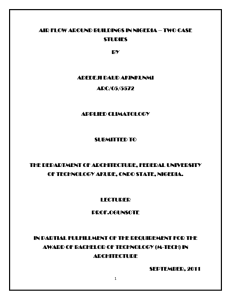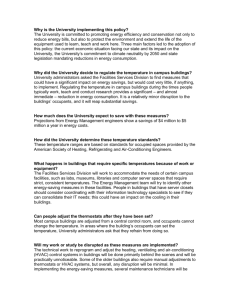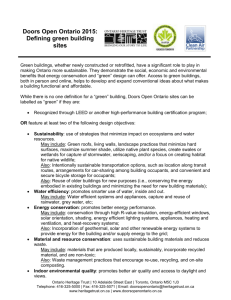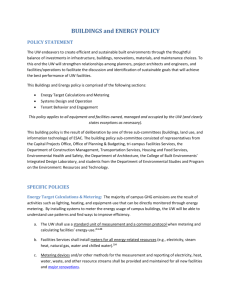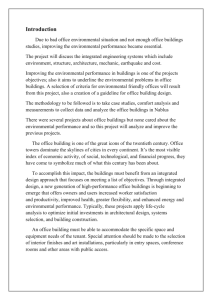ARC-05-5633
advertisement
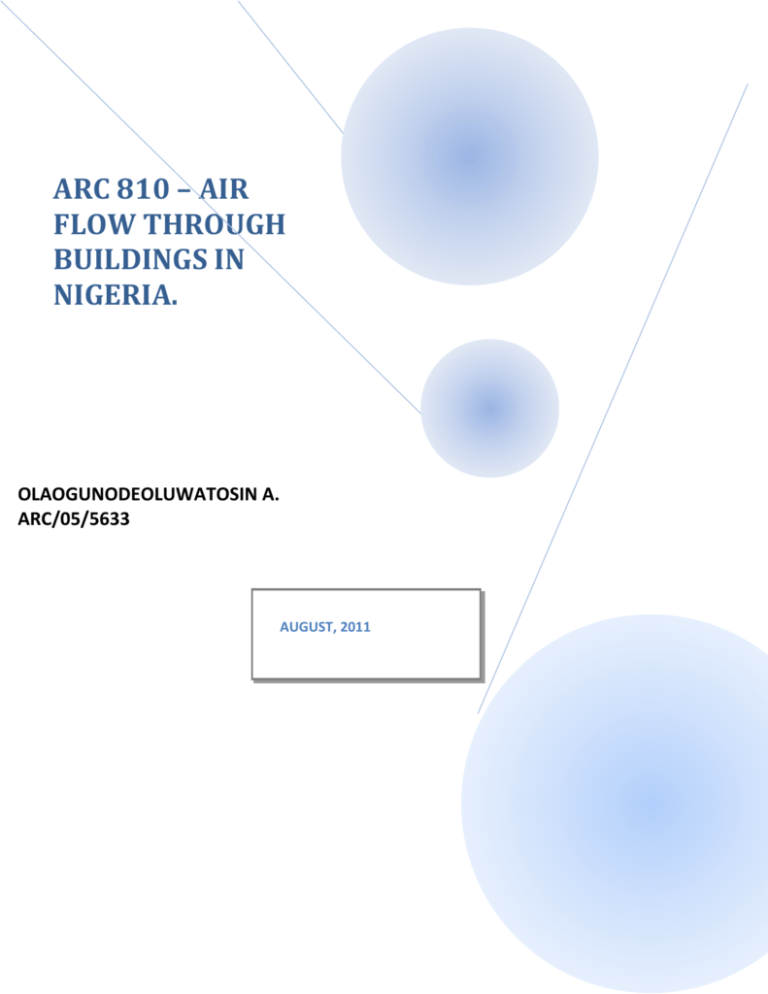
ARC 810 – AIR FLOW THROUGH BUILDINGS IN NIGERIA. OLAOGUNODEOLUWATOSIN A. ARC/05/5633 AUGUST, 2011 ABSTRACT This report describes techniques for observing airflow through buildings. We believe that studies of air motion will most likely be undertaken in search of information about some “larger” building quality or performance issue. For example, an investigator may be evaluating thermal comfort levels for occupants of a building, estimating heat transfer through the envelope of a building, or determining whether the air quality within a building is satisfactory. In each of these instances, tests for air movement will be conducted to provide information that will be used to answer “larger” questions. Although the study exercises described in this report are presented as if they were going to be carried out independently, we expect that the exercises will indeed be used to determine such "larger" issues. 1 OBSERVING AIR FLOW IN BUILDINGS INTRODUCTION The movement of air in a building affects the thermal comfort of occupants, influences the rates of heat gain or loss through the building envelope, and determines whether good-quality indoor air will be present. How a building designer lays out a building, chooses materials, defines building details, and participates in the construction process will influence the nature and magnitude of subsequent air movement in the building. Thermally-comfortable environments depend on four environmental parameters and two personal parameters. The four environmental parameters are the dry-bulb temperature of the air surrounding the occupant; the relative humidity of the air; the (net) radiant exchange between the occupant and the surrounding surfaces; and the rate of air movement around the occupant. Further, the two personal parameters are the metabolic rate for the activity in which the occupant is engaged and the insulative value for the occupant’s clothing ensemble. Thus, one determinant of whether a building occupant will feel thermally comfortable is how rapidly or slowly air moves in the vicinity of the individual. For example, on a day when the air in a building is warm and humid, air flow around an occupant can improve how comfortable the individual will be. Alternatively, when interior air is cool and flows around an occupant, then s/he will perceive the air motion as a draft and may be made uncomfortable by this motion. Second, air movement can induce significant heat exchange through the building envelope. For instance, the infiltration of cold air through the envelope can require that heat be furnished by some internal source to maintain the inside air temperature at a comfortable level. Thus, to reduce heating requirements for building operation, the infiltration of cold air should be curtailed. Conversely, cool external air will often be intentionally admitted into an internal space (by active air-handling systems) to offset or dilute heat build-up that results from internal heat production sources. Supplying good-quality air to building spaces is also a requisite for maintaining healthy and comfortable conditions. The air within a building should be free of dust, dirt, allergens, and any potentially toxic substances; it should be clean-smelling and free from possibly offensive odors; and its humidity should be within acceptable ranges, so that stuffiness will not be experienced by occupants. Further, this good-quality air should be distributed uniformly and at acceptable velocity rates throughout each occupied space. 2 CAUSES OF AIR MOVEMENT IN BUILDINGS The bases for air movement, both inside and outside of buildings, are temperature and pressure differences. When temperature differences exist between adjacent volumes of air, there will be accompanying air differences between these volumes. Or, when an air temperature difference exists between a building surface and the air adjacent to this surface (see Figure 1), the density of the air close to the surface will be different than the ambient air. Where less-dense and more-dense volumes are present, the lighter air will rise and the heavier air will sink, causing air flow. Figure 1-Placing your hand against the interior surface of a window pane will cause the exterior surface to become warmer. This warmth will cause the adjacent air to become Buoyant and to rise. (Drawing by Lisa Kirkendall.) Another example of air flow occurs when air in the atmosphere of the Earth moves (as wind) to a building surface. This air movement exerts a pressure on the building surface. This wind-induced pressure will be incrementally-greater than the ambient atmospheric pressure. If there are openings on the windward side of the building, the pressure difference (between the wind and the building interior) will cause outside air to pass in through the openings, producing air flow within the building. Note that wind flow across the surface of the Earth is the product of temperature differences between adjacent regions of the atmosphere: indeed, both atmospheric pressure 3 systems that exist across large scale areas on the surface of the Earth and localized winds which flow against a building surface result from temperature differences. But, pressure differences can also initiate air flow without a temperature difference occurring between adjacent air volumes. For instance, a fan in an air-handling (ventilation) system will propel air through ducts and out of diffusers. Additionally, occupants can cause air movement as they move around a building. The presence of localized temperature differences in buildings and the accompanying air movements caused by these temperature differences can generally be anticipated. But the rates with which such movements will occur and the patterns that these movements exhibit are usually difficult to predict. So, determining the patterns and estimating the rates of air motions resulting from temperature differences will commonly require observations for each specific instance. Two important distinctions can be used to describe air flow in buildings and to understand what incites this phenomenon: whether the air movement results from active or passive means; and whether air flow is present because of intentional or accidental interventions? For example, the fan-powered air flow (initiated by an air-handling system) forces air through ducts and ejects the air into rooms. The air movement in the ducts is driven by a fan which pressurizes the air. Thus, the pressure difference between the duct-enclosed air and the room air enables the entering air to pass into and flow throughout the room. Such air movement results from an active control system which is operated intentionally. Indeed, this air handling system operates because an engineer has designed the system to supply specific volumetric flow rates. 4 Figure 2: Air flow is promoted by a "stack effect", as warm air rises in the house and exits at the roofline vents. Exterior air is drawn in through the floor vents (and, also, through the jalousies in the walls.) The fan aids the ascension of the war med air. (Drawing by David Hudacek.) (described in liters per second or cubic feet per minute) moving at expected velocities (meters per second or feet per minute) to various locations in the building. As a second example, a “stack effect” occurs when there is a temperature difference between volumes of air in a room: when the air at lower heights in a room is warmer than the air at upper heights, then the lower-height air will be less dense and will rise (and be replaced by more dense air.) If the temperature difference between the lower and upper heights is produced by the passage of solar energy into the room through windows (at the lower height), then this “stack effect” behavior is a passive phenomenon and may be an accidental result (i.e., the building designer had not foreseen that entering solar energy would overheat the lower volume of the room.) But, if the presence of a temperature difference between the lower and upper heights of a room is anticipated by the building designer (perhaps heat is generated during food preparation), then the designer can incorporate operation strategies to offset the discomforting heat gain. Thus, the temperature difference can promote a “stack effect” and induce the movement of the warm air away from the occupants (see Figure 2). In this latter instance, inclusion of lower and upper-wall venting can enhance air flow in the building providing an intentional and passive remedy. Additionally, a slowly-revolving ceiling fan can further enhance the “stack effect” movement of the air (thereby offering an intentional, active treatment for offsetting the heat gain.) 5 Finally, designers may intentionally rely on unpredictable and possibly difficult-tocontrol means to promote air movement in buildings. One example of this practice is using infiltration to provide adequate fresh air for the occupants of a building. Air infiltration is generally caused by pressure differences between the external air and the internal air. These pressure differences can result from wind-loading, wind flow onto the exterior surface of a building or from a “stack effect” (e.g., where warm air in a space rises, sucking in outside air through the building envelope.) In either of these instances, the primary pathways for air admission are through cracks in the building envelope or through opened operable parts in the envelope (e.g., doors and windows) Because anticipating (and then providing controls for) all of the likely pathways through which infiltration will occur is virtually impossible, some infiltration of external air is unavoidable. Thus, a designer seeking to insure that some fresh air will be present for building occupants can rely on it, arriving by infiltration. To control the rate of infiltration through a building envelope, it is essential that envelope components fit tightly and those openings in the envelope be used judiciously. But it is difficult to predict with certainty the amount of infiltrating air that will pass through building envelope. Further, regulating air infiltration may require special attentions not only by the designer, but also by the builder, maintenance person, and occupant. WHERE AIR FLOW IN BUILDING SPACES CAN AFFECT OCCUPANT COMFORT There are numerous conditions in our present-day buildings, where air movement affects not only the functioning of building spaces, but also how occupants feel in these spaces. For instance, large, cold window surfaces in buildings will promote air movement (by convective drafts), if not suitably treated. A convective draft forming off of a cold window surface, suppose that you occupy an older house, probably one built before the introduction of the various energy conservation codes that now regulate the compositions of new building envelopes. Windows in the older house are likely to be glazed with single-pane assemblies. So, on a winter day if the ambient outside air temperature is 0 C (32 °F) and the inside (room) air temperature is 20C (68 °F), then the interior surface temperature of an unheated glass pane will be about 5 C (40 °F). Because a temperature gradient would then exist between the room air and the interior surface of the glass light, convective heat exchange would occur in the 6 vicinity of this window surface. As the air layer adjacent to this inside surface is cooled by its proximity with the glazing pane, the air layer would flow down and inward from the building envelope across the floor of the room. A more precise explanation of the heat transfer mechanisms present for this scenario would state that the transfer from the air molecules in contact with the window surface occurs conductively. As these molecules lose heat, the volume of space they occupy becomes smaller. Then, because this localized volume is denser than the surrounding air, the denser volume will move downward as this denser volume loses buoyancy and will be replaced by warmer air. This overturning of air volumes resulting from temperature differences is known as convection. Heating with a finned-tube radiator The composition of a finned-tube radiator includes a copper tube with many steel fins joined to the tube at right angles to the principal axis of the tube. Then, this finned-tube is mounted inside a sheet metal enclosure which has a vented opening along the top of the enclosure. This assembly functions with the passage of hot water (at about 60-82 C [140-180 °F]) through the tube. Heat from the water is conducted to the copper tubing and, thence, to the fins. The warmed fins then promote convective movement of air in the vicinity of the finned-tube assembly. Note that this assembly functions most usefully as a convector and less so as a radiator (i.e., a more appropriate appellation for this assembly is finned-tube convector.) Sitting under an air-admitting diffuser In many internal-load-dominant buildings a principal function of the mechanical (HVAC) system is the dilution of the heat generated by internal heat production sources. Often in such buildings this heat dilution is accomplished by supplying relatively cool air (at temperatures of about 10-15 C [50-60 °F] to the overheated spaces. For these buildings conventional design practice calls for this cool air to be supplied through diffusers located in the ceiling (or, less often, in the upper walls.) The entering air leaves the diffusers at velocities of 2.5 m/s [500 fpm] or greater. If occupants sit directly under these diffusers and the air is projected downward (rather than being spread outward), the occupants will likely be chilled by the cold air and will be made thermally uncomfortable. 7 Encouraging the natural ventilation of interiors of buildings subjected to warm-humid climates In regions where external air temperatures and relative humidities are frequently above accepted thermal comfort ranges (e.g., temperatures above 27 C [ca. 80 °F] and humidities greater than 60%), a traditional design strategy employs building forms that are single-banked (i.e., floor plans that minimize or eliminate the use of floor-to-ceiling partitions [see Figure 6].) Additionally, this strategy incorporates large, operable fenestration assemblies, which when left open will allow external air to flow across the building. Thus, any gentle breezes can be admitted to the building interior and pass over and around building occupants providing them with beneficial convective (and evaporative) cooling. Another component of this strategy involves raising the primary living areas above the existing ground plan. The premise of this last component is that ambient air flow will be freer and less inhibited by natural ground forms and built structures. Resolving each of these four situations and their relationships to air flow Each of these four examples illustrates situations where performance testing is needed to ascertain how well (or poorly) the form, composition, and operation of a building may support the building occupants. The air flows resulting from the first and third examples will cause building occupants to feel cold, producing uncomfortable conditions. For someone charged with correcting occupant discomfort for these two conditions, an initial task would be to ascertain why the occupants felt uncomfortable. After conjectures about possible causes of the discomforts had been proposed, series of tests might then be conducted to verify the accuracy of the inferences. If the tests confirmed the predicted causes, suitable corrective means could be suggested and undertaken. Following the completion of these corrections, further tests could then be performed to insure that the corrective means were adequate. Additionally, the occupants could be interviewed to ascertain whether (or not) they felt more comfortable. The second example describes a common means for warming the perimeter surfaces of buildings. Heat passes from the finned-tube convector to window and other perimeter surfaces, principally to lessen temperature differences between cold window surfaces and the clothing and exposed skin of occupants. To demonstrate that a finned-tube convector provides adequate heating for a window surface, window surface temperatures could be measured, both when the 8 finned-tube convector is operating and when hot water passage through the finned-tube is halted (and the enclosed water has cooled.) Also, for the period when the finned-tube convector is operating, the velocity of air rising from the convector could be measured. Further, if the temperature of the hot water could be established (using a surface-contact temperaturemeasuring device), then the observed air velocity could be linked to a specific water temperature. Subsequently, if the temperature of the hot water flowing through the finned-tube could be raised or lowered, then air velocity measurements for alternative water temperatures could be performed. From several measurements of alternative water temperatures and resultant air velocities, it may thus be possible to develop a relationship describing finned-tube water temperatures and associated air velocities. Also, the temperatures of the warmed window surface could likewise be measured and compared for the alternative water temperatures and the velocities of the air rising from the convector. Thus, this second example offers an opportunity to examine how a common heating device participates in the maintenance of occupant thermal comfort. Further, this example considers how some operating parameters of the finned-tube convector could influence air flow in the vicinity of the convector. By examining and relating water temperatures, air flow rates, window surface temperatures, and perceptions of comfort by occupants, it may be possible to detect optimum conditions for the operation of the finned tube convector. For example, using natural ventilation to cool a building space the effectiveness of this conditioning strategy could be tested. If a designer is considering the use of such a conditioning strategy in a new building, then one would need to determine how much air flow is needed to produce comfortable conditions. Tests could be conducted on similar existing buildings (if any were available) or on reduced scaled models. Any data gathered from these activities could then inform design decisions. Later, after the completion of construction of the building (with its various means for fostering air movement), the designer could examine the effectiveness of the natural ventilation devices to determine how well the observed air flows matched predicted air flows and to what extent occupant thermal comfort needs were satisfied. The results of such tests and comparisons could provide useful information for future building projects which may present conditions similar to those found for the completed building. 9 OTHER SITUATIONS WHERE AIR FLOW PATTERNS MAY BE OBSERVED AND STUDIED Evidence that air flow occurs in buildings can be found in a number of additional examples. For instance, if you look across rays of sunlight as they pass inward from a closed window, you will often see motes of dust as they move randomly in the air crossed by the sunlight. If you wished to accentuate the dust movement, try slapping a chalk eraser on a surface near the streaming sunlight and watch the great increase in the dust presence. Another example of air movement can be observed by your sense of smell: when someone walks by you wearing a strong cologne or perfume or enters a room in which you have been sitting for some period of time, often you will immediately be able to detect the introduction of this new scent. A third example of discernible air movement can be seen when air flows around and across a hanging mobile: the air motion will cause the mobile to twirl in space. Additional related examples where air movement causes the motion of usually-stationary objects include the rotation of a toy pinwheel and papers blown off a desktop when a window is opened. What parameters could be manipulated to alter performance? Where potential problem areas exist, what solutions should be employed? Where benefits are possible, are there means for obtaining yet-better performances? When considering the probable nature of air flow in a building, the key steps during programming involve being able to anticipate problem areas and to understand how beneficial situations can be exploited. An extremely useful complement to this first key step is recognizing potential operating difficulties and knowing how to find solutions. Means for identifying problems or benefits can include the use of mental or written checklists (as derived from past experiences or from the perusal of technical literature), brain-storming among team members, or guidance from consultants. Once the design team has accumulated sufficient information from the programming phase, the members can commence schematic designing. During this phase the principal activity involves creating a building organization that responds to formal requirements, occupant needs, and important physical behaviors (as identified during the programming phase.) Because of the complexity of considering many potentially disparate bits of information, the schematic design process will often involve several iterations. Further, any design solution established during this phase should only be regarded as a first-approximation. But at least this solution furnishes a starting point for the subsequent fine-tuning that is usually conducted in the later design phases. 10 The more systematically and rationally the information-gathering has been accomplished during programming and the more closely the schematic designer pays heed to such information, the higher the probability that any schematic solution will satisfy the building criteria established during programming. After one (or more) schematic design solution(s) has (have) been produced, the design team proceeds to the third phase, design development. During this phase the team seeks to evaluate and choose from alternative schematic designs, if more than one design has been established. The chosen schematic design is then analyzed, and its components are tested and resolved. Where design aspects concerning air flow in buildings are found, these aspects can be evaluated by a variety of means. First, published literature can be examined for relevant information. Second, further advice from consultants can be sought and integrated with the design proposal. Third, analysis based on either the employment of accepted analytic protocols delineated in the technical handbooks and standards or computations obtained from software packages can be undertaken. Fourth, physical models usually, constructed at reduced scale can be assembled and tested. And, fifth, tests can be carried out on existing buildings which are similar to (or different from) the proposed building, and the data from such tests can be applied to the design proposal. Throughout these evaluations the goal of the design team should be to seek information which can support the design proposal or lead to the successful modification of the proposal. Ultimately, the purpose of this design development phase is to fine-tune the design proposal, to arrive at a specific overall building form, to decide on exact dimensions for the building and its components, and to identify appropriate materials and assemblies. After such information and definitions have been established, then the design team can undertake the preparation of the construction documents. But, for the characterization and/or regulation of airflow in buildings, their roles appear less central. The leakage of air through the building envelope is caused by pressure differences between the air volumes on the exterior and interior sides of an envelope. Such pressure differences can be caused by wind-loading: the incident wind blows on a building elevation, exerting a pressure level that is incrementally greater than the ambient pressure experienced inside the building. At the opposite side of the building (from the incident wind), a leeward situation exists with the exterior pressure on this opposite side being slightly less than the 11 ambient pressure condition present within the building. In addition to pressure differences caused by wind-loading, pressure differences can also be the result of stack effects. For stack effects, air warmed by heat sources for example, solar radiation, people, or lighting systems will become more buoyant (less dense) and will rise upward through a building. As in these stack effects develop, pressure differences form across the envelope, thus promoting air leakage through the envelope. For assessing air leakage through a building envelope, several important questions can be asked. Along what paths across the envelope does such leakage occur? At what rates does leakage happen? What environmental, building, and operational parameters affect leakage rates? Can leakage rates be established for individual paths or can the rate of leakage only be determined in an overall manner (i.e., for the whole building volume?) And, finally, what corrective means are available for altering observed leakage rates, and by how much can leakage rates be reduced by undertaking these corrective means? The term air exchange generally refers to the passage of some volume of air between an individual room or a whole building and the building exterior. This term most often is used to describe the volumetric flow rate in units such as liters per second (l/s) or cubic feet per minute (CFM) achieved by a mechanical (HVAC) system or some component of the system. Thereby, air exchange can indicate at what rate Ventilation air is provided to a space by the mechanical system or how rapidly the system exchanges “used” air with “fresh” air. But the term is also used to characterize the infiltration rate for an overall building or, even, for individual rooms. Regardless of whether the air exchange is produced by the operation of a mechanical system or by infiltration action, such exchange may be defined by answering questions similar to those stated in the previous paragraph. At what rates does air exchange happen? What environmental, building, and operational parameters affect exchange rates? What corrective means are available for altering observed exchange rates? And by how much can exchange rates be reduced by undertaking corrective means? A CATALOG OF TECHNIQUES FOR ASSESSING AIR MOVEMENT IN BUILDINGS Sometimes, the best way to recognize the motion of air within a building is to rely on one (or another) of our five senses. For example, we have suggested using chalk dust to make visible the air movement present in the incoming rays of sunlight. We have also mentioned how the occupant of a room can become aware of the scent of cologne or perfume worn by someone 12 newly entering that room. Thus, the sense of smell provides the means for observing air motion. We can discern air flow by our sense of feeling, either by wetting a finger and holding it up into what we anticipate to be a moving stream of air or we may feel air moving across our bare skin, especially, when the air is much cooler than the skin. Hearing can provide evidence of air movement when we are outside of a building and we observe the whoosh of windblown air. Alternatively, for fan-driven air within a building, we can often hear fan noise borne by the moving air. Also, we can sometimes discern air movement as fan-blown air passes over the blades of a ceiling diffuser causing them to vibrate. In some instances, two senses functioning together can make us aware of air movement. For example, we can observe air movement in the presence of burning incense. We see smoke rising from the smoldering incense stick, and we smell the aroma of the combusted incense. A number of other simple techniques can be employed to observe air movement in a space. A well-balanced mobile can offer an attractive, pleasing demonstration of air motion. Or we might use a child’s pinwheel or a helium-filled balloon to detect moving air streams. We can watch the flame of a candle to see if the flame moves and flickers, particularly when a door between this space and an adjacent one is opened or closed. We also could bring some dry ice into a room and observe the motion of the vapor as the solid sublimes. And, if the air stream moves at a rapid enough pace, usually-stationary, loose papers lying on the horizontal surface of a table (or desk) will be blown about. In conclusion, we recommend using a powder “gun” to inject finely-divided particles into the air. If this air is moving, then its motion can be readily seen as the powder particles disperse. Essentially, propelling the particles into air to see if the air is moving is an action similar to beating a chalk eraser against some hard surface. In both instances the finely-divided particles appear buoyant and are carried by the moving air stream. If you wish to accentuate the visibility of these particles, you can project a laser beam through the cloud of particles. Indeed, a rubycolored laser beam passing across a moving dust cloud can make a very engaging display. Another method for indicating air flow is to use a helium bubble machine. With this device small buoyant droplets filled with helium gas can be injected into moving air. 13 REFERENCES Brooks, M.S., “Rationalizing Wall Performance Criteria”, Proc. Sixth Conference on Building Science & Technology, Toronto, March 5-6, 1992, Pp. 145-161. Brown, W.C., Bomberg, M.T., Ullet, J.M. and Rasmessen, J. “Measured Thermal Resistance of Frame Walls with Defects in the Installation of Minerals Fibre Insulation”, J. of Thermal Insulation and Building Envelopes, Vol. 16, April 1993, Pp. 318-319. Diamond, R.C., H.E. Feustel, and D.J.Dickerhoff. (1996). “Ventilation and Infiltration in High Rise Apartment Buildings,” Lawrence Berkeley Laboratory Report, LBL-38103, Berkeley, California. Feustel, H.E. and R.C. Diamond (1996). “Diagnostics and Measurements of Infiltration and Ventilation Systems in Three High-Rise Apartment Buildings,” in the Proceedings of the 1996 ACEEE Summer Study, vol. 1, American Council for an Energy-Efficient Economy, Washington DC, 1996. Kelly, Mark E., McQuail, John E., and O'Brien, Robert. (1992). “Case Study of Ventilation Improvements in a Multifamily Building," in the Proceedings of the 1992 ACEEE Summer Study, vol. 2, American Council for an Energy-Efficient Economy, Washington DC, 1992. 14
